#draw dinovember 2021
Explore tagged Tumblr posts
Text
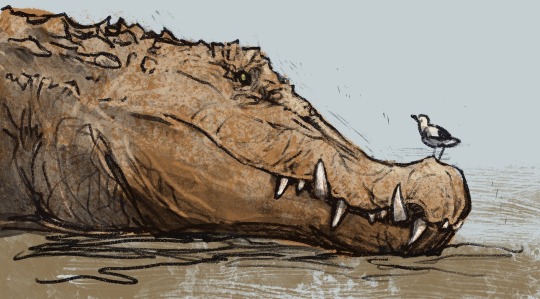
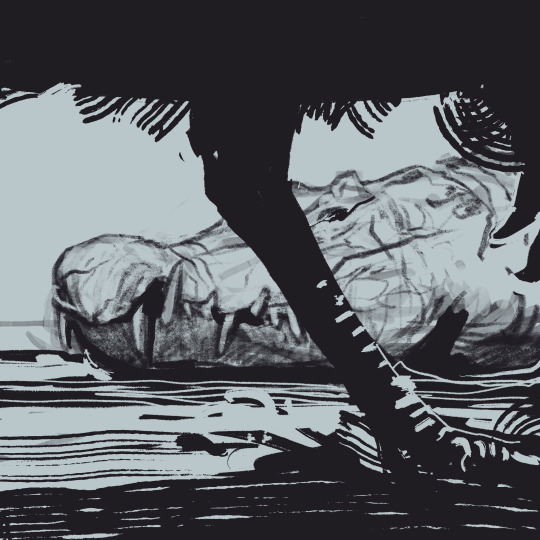
bonus post today for maysozic: the Boar Croc Kaprosuchus saharicus
#paleoart#paleoblr#kaprosuchus#maysozoic#procreate#digital#let’s see if we can do another drawing challenge#haven’t tried since dinovember in 2021 to learn this drawing program so it’ll be fun to compare
890 notes
·
View notes
Text

Archovember Day 18: Moganopterus zhuiana
Moganopterus is a ctenochasmatid pterosaur from Early Cretaceous China. It is only known from a skull and some neck vertebrae, but this is enough to see that it was a pretty strange-looking creature. The skull was 3.12 feet long: the longest known of any toothed pterosaur. By estimating from the size of the skull and neck and comparing Moganopterus to relatives, we can estimate a wingspan of around 23 feet!
#my art#Moganopterus zhuiana#Moganopterus#ctenochasmatids#pterodactyloids#pterosaurs#archosaurs#archosauromorphs#Archovember#Archovember 2021#Dinovember#Dinovember 2021#Draw Dinovember#Draw Dinovember 2021#SaritaDrawsPalaeo
558 notes
·
View notes
Text

Dinovember, day 28! Not dinosaurs, but a pair of pantosaurus cruising through the Sundance Seaway, cronchin’ on fish as they go 🐟
This is it. This is my favorite page from the whole series. I love marine reptiles ❤️
EDIT, 1/11/22: This entire Dinovember series has been compiled and is now available for purchase on Gumroad! The pages can be printed, or thrown into a digital program! Check it out HERE!
#art#digital art#sketch#lineart#coloring book#dinovember coloring book#dinovember#dinovember 2021#draw dinovember#dinosaur#non-dinosaurs#marine reptile#plesiosaur#cryptoclidid#pantosaurus#fish#leptolepis#ocean#Sundance seaway#Morrison formation#late jurassic
86 notes
·
View notes
Photo

Starting off Dinovember a little late this year with the early Jurassic ceolophysoid Podokesaurus holyokensis, from modern-day Northeastern USA, North America! It was discovered near the women-centered Holyoke college in Massachusetts. I based its physique on an outdated description of it having a very long tail that dragged on the ground, and its colors and furred look on the Marbled Polecat.
#dinovember#dinovember 2021#dinosaurs#jurassic#dinosaur#theropod#draw dinovember#podokesaurus#coelophysis#digital art#my art
40 notes
·
View notes
Text

I posted 8,627 times in 2022
That's 8,627 more posts than 2021!
352 posts created (4%)
8,275 posts reblogged (96%)
Blogs I reblogged the most:
@detergentt
@todaysbird
@kt--extinction
@sharpnessplusone
@paleontologylife
I tagged 1,319 of my posts in 2022
#digital drawing - 60 posts
#dinosaur - 57 posts
#paleoart - 52 posts
#me - 41 posts
#what - 34 posts
#shitpost - 34 posts
#pencil drawing - 30 posts
#dinovember - 28 posts
#digital doodle - 25 posts
#prehistoric planet - 24 posts
Longest Tag: 127 characters
#i don’t like seeing blogs that consist of only a single post or nothing at all because then i can’t tell if they’re bots or not
My Top Posts in 2022:
#5
Watched The Thief and the Cobbler recently and felt like making this


88 notes - Posted November 9, 2022
#4

(teleports behind you) “It’s Morbin Time.”
88 notes - Posted June 16, 2022
#3


No further explanation
102 notes - Posted June 3, 2022
#2

Probably could’ve made the feet better.
113 notes - Posted November 24, 2022
My #1 post of 2022
We Do A Little Arson


352 notes - Posted May 26, 2022
Get your Tumblr 2022 Year in Review →
0 notes
Text

Archovember Day 24: Cricosaurus suevicus
Last year I drew Dakosaurus, and now it’s time for its skinny cousin Cricosaurus to take the spotlight.
Cricosaurus is a genus of long-snouted Metriorhynchid crocodyliform fully adapted to marine life. Like most other Metriorhynchids, it had paddle-like feet, a tail fluke, and smooth skin. Cricosaurus adults and juveniles both had well-developed salt glands, which allowed them to drink salt water and eat seafood without dehydrating. It also seemed to have a large pelvic opening which would have allowed it to give live birth.
Cricosaurus suevicus shared its territory with a variety of other marine crocodylomorphs in the Late Jurassic ocean which would one day be Germany. It is suspected that this was possible due to niche partitioning: larger, short-snouted metriorhynchids like Dakosaurus and Geosaurus would have been the apex predators, while smaller, long-snouted species like Rhacheosaurus and Cricosaurus, as well as the teleosaurid Steneosaurus, would have preferred different types of fish. Cricosaurus suevicus was about 6 feet long.
There were at least 11 species of Cricosaurus, but I chose Cricosaurus suevicus because I liked the pose of its fossil. 😅
#my art#Cricosaurus suevicus#Cricosaurus#Metriorhynchids#crocodylomorphs#pseudosuchians#Archosaurs#archosauromorphs#Archovember#Archovember 2021#Draw Dinovember#Draw Dinovember 2021#Dinovember#Dinovember 2021#SaritaDrawsPalaeo
163 notes
·
View notes
Text

Archovember Day 13: Yi Qi
While other dinosaurs were busy figuring out flight through the use of vaned feathers, the scansoriopterygids of the Jurassic attempted something much different.
Yi Qi was a small arboreal theropod dinosaur from middle to late Jurassic China. It had an enlogated third finger as well as a long, bony strut attached to its wrist. These appendages appear to have supported a membrane of skin, similar to that of bats! It probably could not fully fly, but would have used these wings to glide from tree to tree. It also sported a thick coat of simple feathers, covering most of its body except for the wings!
Yi Qi was the first of this family to be discovered with this unique adaptation, though the more recently discovered Ambopteryx also has these strange wings.
Yi Qi is also one of the few non-avian dinosaurs we can accurately guess the color of! Twelve positions on the fossil were scanned for melanosomes, which are organelles that determine pigments. All of the body feathers (at least in the positions checked) had eumelanosomes, which determine darker colors. The head feathers and wing membranes had phaeomelanosomes, which determine lighter colors.
Yi was fairly small, about the size of a pigeon, and would have weighed around 380 grams.
#my art#Yi Qi#Yi#Scansoriopterygids#theropods#saurischians#dinosaurs#archosaurs#archosauromorphs#Archovember#Archovember 2021#Draw Dinovember#Draw Dinovember 2021#Dinovember#Dinovember 2021#SaritaDrawsPalaeo
120 notes
·
View notes
Text

Archovember Day 19: Sinosauropteryx prima
In life, Sinosauropteryx would have been just like any other compsognathid. But it is very important to paleontology for a variety of reasons.
For one, it was the first non-avialan (bird-winged) dinosaur to be discovered with evidence of feathers. Not only that, but these feathers were so well-fossilized, that we could determine the structure and placement of their melanosomes, and thus what colors and patterns the dinosaur would have been! Thus, Sinosauropteryx was the first non-avialan dinosaur whose life appearance we can be almost certain of! We know that it was covered almost completely in soft, down-like feathers, had a long striped tail, was countershaded with reddish-brown feathers on top and white on the bottom, and had a raccoon-like band across its eyes.
Sinosauropteryx lived in Early Cretaceous China. It was only around 3 feet long, about the size of a small cat. It was smaller than the European Compsognathus, but had a very long tail, the longest (in proportion to its body) of any theropod! One specimen was preserved with a lizard in its gut, and another with mammal jaws, indicating it would have chased down small, fast-moving animals. Aside from its prey, it would have lived alongside various small birds, the therizinosaur Beipiaosaurus, the bipedal ceratopsian Psittacosaurus, the microraptorine Sinornithosaurus, the troodontid Mei, the dromeosaur Tianyuraptor, the much larger compsognathid Sinocalliopteryx, the sauropod Dongbeititan, and the tyrannosauroids Dilong and Yutyrannus.
#my art#Sinosauropteryx#Sinosauropteryx prima#compsognathids#theropods#saurischians#dinosaurs#archosaurs#archosauromorphs#Archovember#Archovember 2021#Draw Dinovember#Draw Dinovember 2021#Dinovember#Dinovember 2021#SaritaDrawsPalaeo
87 notes
·
View notes
Text
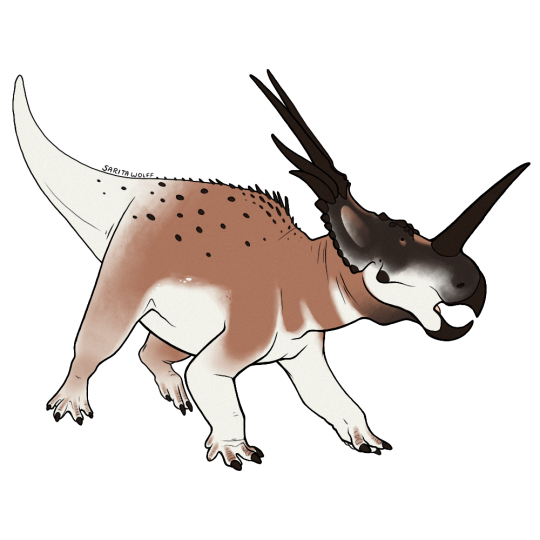
Archovember Day 16: Styracosaurus albertensis
Second only to Triceratops, Styracosaurus is undoubtedly the most famous ceratopsian, and for good reason. Instead of having three horns on its face, it had one impressively long forward-pointing nose horn and 4-6 large spikes jutting from its frill. While only about half the size of Triceratops, it was still a large animal, a bit bigger than a common hippopotamus.
As far as we know there are (maybe?) only two species of Styracosaurus, however, frill spikes have a lot of variation between individuals. On some, the spikes at the midline of the frill point towards each other, while on others they point outward. Some have 4 large frill spikes, while some have six. Some have smaller hooks on their frill alongside the spikes, while in others these are reduced. In one specimen, the frill horns are asymmetrical and look to have simply grown this way, and not been due to an injury.
S. albertensis lived in Cretaceous Alberta, Canada, alongside other ceratopsians Centrosaurus and Chasmosaurus, a variety of hadrosaur species, ankylosaurids Edmontonia and Euoplocephalus, and may have been preyed upon by the tyrannosaurids Gorgosaurus and Daspletosaurus (though neither of them would have stood a chance against a healthy full grown Styracosaurus.)
As a ceratopsian, Styracosaurus was likely a plant eater, but may have also scavenged carrion with its sharp beak.
#my art#Styracosaurus albertensis#Styracosaurus#ceratopsians#Ornithischians#dinosaurs#archosaurs#archosauromorphs#Archovember#Archovember 2021#Draw Dinovember#Draw Dinovember 2021#Dinovember#Dinovember 2021#SaritaDrawsPalaeo
87 notes
·
View notes
Text
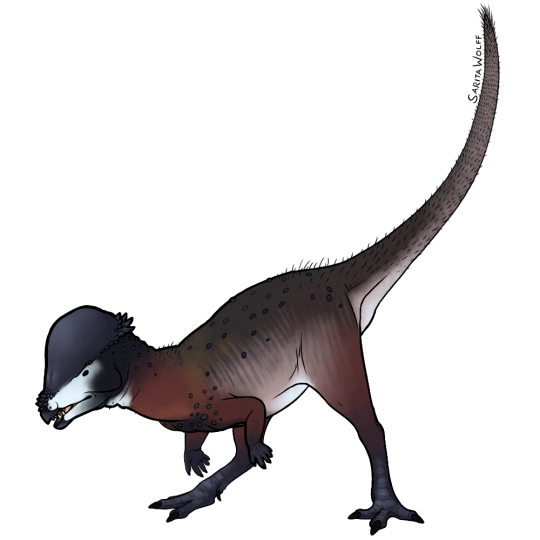
Archovember Day 22: Prenocephale prenes
Prenocephale was a mid-size Pachycephalosaurid dinosaur from Late Cretaceous Mongolia. It was 8 feet long and stood about as tall as a great dane.
Prenocephale had a round, sloping, domed head surrounded by a row of small spikes and bumps. It was originally thought that they would use these domed heads to headbutt like goats, but further inspection of fossils show they were probably more likely to ram into the flanks of rivals, rather than their heads.
As with most Pachycephalosaurids, paleontologists do not know what Prenocephale’s diet was like, but it is assumed that it at least ate plants. It may have been an omnivore, feeding on both plants and insects.
Prenocephale is hypothesized to be the adult form of “Homalocephale,” or at least a close relative.
#my art#Prenocephale prenes#Prenocephale#Pachycephalosaurids#Ornithiscians#dinosaurs#archosaurs#archosauromorphs#Archovember#Archovember 2021#Draw Dinovember#Draw Dinovember 2021#Dinovember#Dinovember 2021#SaritaDrawsPalaeo
64 notes
·
View notes
Text
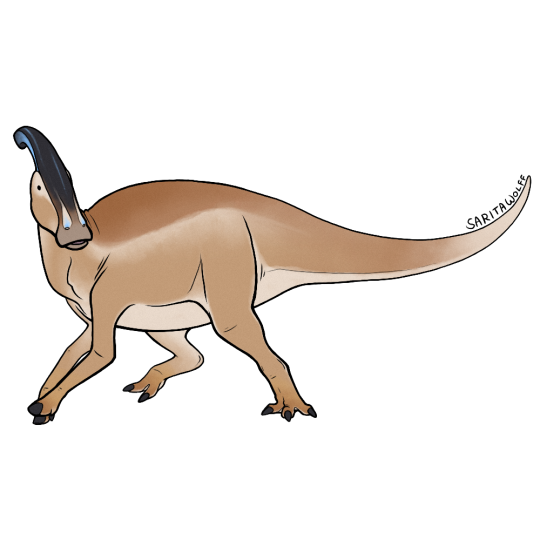
Archovember Day 30: Parasaurolophus walkeri
And last but certainly not least, Parasaurolophus walkeri. I try to include a “fan favorite” as the concluding archosaur for Archovember, just to keep people going. 😅
Parasaurolophus walkeri is one of the, if not the, most universally recognized hadrosaurs.
They would normally walk on four legs, but could also rear up on their hind legs and even walk and run this way, probably to browse on higher branches or even to intimidate rivals or predators. And they would have been pretty intimidating, if not for sheer size alone: they were about the size of an elephant, and would have been even larger reared up.
But Parasaurolophus is probably most famous for it’s crest, which we don’t really know the function of for sure. It could have been used as a resonating chamber, or a hearing amplifier, for thermoregulation, or simply just a visual indicator of sex and species (as there were at least three different species.) Despite its popularity, Parasaurolophus was rather rare, and we only have a few good specimens.
Parasaurolophus walkeri lived in Late Cretaceous North America. It would have lived alongside fellow hadrosaurs Gryposaurus and
Corythosaurus, the ceratopsians Styracosaurus, Centrosaurus, and Chasmosaurus, ankylosaurs like Dyoplosaurus, Euoplocephalus, and Edmontonia, pachycephalosaurs like Stegoceras and Foraminacephale, dromeosaurids such as Saurornitholestes and Dromaeosaurus, and troodontids like Latenivenatrix and Stenonychosaurus. It would have been preyed on by the tyrannosaurs Daspletosaurus and Gorgosaurus.
#my art#Parasaurolophus walkeri#Parasaurolophus#ornithopods#hadrosaurs#Ornithischians#dinosaurs#archosaurs#archosauromorphs#Archovember#Archovember 2021#Draw Dinovember#Draw Dinovember 2021#Dinovember#Dinovember 2021#SaritaDrawsPalaeo
55 notes
·
View notes
Text

Archovember Day 4: Baurusuchus salgadoensis
Baurusuchus was a terrestrial crocodyliform predator/scavenger also from Brazil, but this time in the late Cretaceous. At 11.5 - 13.1 feet long and around 176 lbs, it stalked through a hot and arid climate, likely digging for water during the dry seasons. It had a powerful bite, and could snap it’s jaws closed very quickly. Baurusuchus would have competed with abelisaurid dinosaurs such as Pycnonemosaurus for food.
#my art#Baurusuchus salgadoensis#Baurusuchus#pseudosuchians#archosaurs#archosauromorphs#Archovember#Archovember 2021#draw dinovember#draw dinovember 2021#dinovember#dinovember 2021#SaritaDrawsPalaeo
55 notes
·
View notes
Text

Archovember Day 1: My Choice
I was at first going to do a dromeosaur since I had to leave them out this year (oops. Next year for sure) but with the publication of Kunpengopterus antipollicatus earlier this year I realized I simply must draw this unique pterosaur.
While the other species of Kunpengopterus, K. sinensis, was described in 2010, K. antipollicatus was described early 2021, and this description managed to “escape” paleontological circles and into the general media, where it quickly earned the common name “Monkeydactyl.” This is due to the fact that it has opposable thumbs, a feature that’s very rare among non-mammals. This is also the earliest known record of opposed thumbs!
Kunpengopterus antipollicatus lived in China during the middle-late Jurassic, and it’s thumbs were likely an adaptation to an arboreal lifestyle. Disregarding its digits, this was a relatively small, unassuming darwinopteran with an estimated wingspan of 33.5 inches. To go with the monkey theme, this would make it about the size of a small tamarin or marmoset. (In fact, the colors I used are inspired by the golden-headed lion tamarin!)
#Kunpengopterus antipollicatus#Kunpengopterus#monkeydactyl#pterosaurs#archosaurs#archosauromorphs#archovember 2021#dinovember 2021#draw dinovember 2021#my art#SaritaDrawsPalaeo#archovember#dinovember#draw dinovember
64 notes
·
View notes
Text
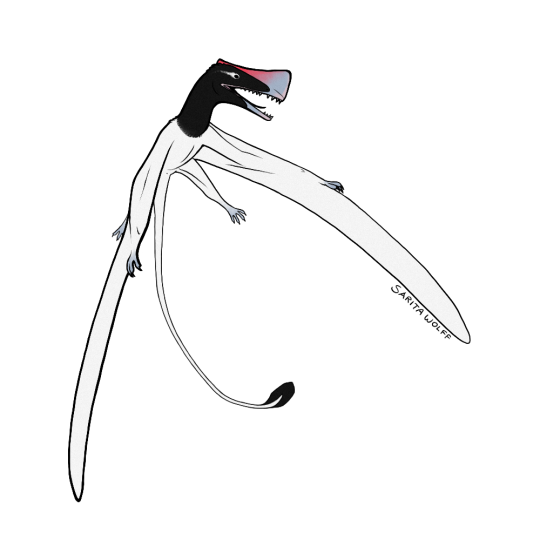
Archovember Day 28: Austriadactylus cristatus
Austriadactylus cristatus was a ramphorhynchoid pterosaur from late Triassic Austria. It had a unique crest: it got wider as it got closer to the snout. It is not really known where Austriadactylus belongs in the pterosaur order, other than it is an Eopterosaur (a group of basal pterosaurs from the Triassic.) It was very small, about the size of a fruit bat with a 3 foot wingspan.
#my art#Austriadactylus cristatus#Austriadactylus#pterosaurs#archosaurs#archosauromorphs#Archovember#Archovember 2021#Draw Dinovember#Draw Dinovember 2021#Dinovember#Dinovember 2021#SaritaDrawsPalaeo
49 notes
·
View notes
Text

Archovember Day 6: Guanlong wucaii
Long, long before Tyrannosaurus rex stomped its way through North America, a very different Tyrannosauroid lived across the world in late Jurassic China. Guanlong means “crown dragon,” and one look at it tells us why. This small Tyrannosauroid had a delicately thin yet large crest on its head, likely used for display.
Unlike later tyrannosauroids, Guanlong had long, three-fingered hands that it could use to grab and tear at prey. Being a mid-size predator, it would have hunted smaller dinosaurs but also served as prey for larger theropods like the allosaurid Yangchuanosaurus. It was about the size of the Raptors on Jurassic Park.
#my art#Guanlong wucaii#Guanlong#tyrannosauroids#theropods#saurischians#dinosaurs#archosaurs#archosauromorphs#Archovember#archovember 2021#draw dinovember#draw dinovember 2021#dinovember#dinovember 2021#SaritaDrawsPalaeo
38 notes
·
View notes
Text

Archovember Day 25: Stegosaurus stenops
One of the most famous dinosaurs and certainly the most famous stegosaurian dinosaur, Stegosaurus certainly has a recognizable silhouette.
The double row of plates on its back are its most defining feature. The number of plates vary, Stegosaurus could have had between 17 and 22 of them, and they continued growing after the animal reached its adult size. They were attached to the skin, not the bone, so its hard to tell how they were arranged on the back from fossils, but the most recent evidence shows that they possibly grew in an alternating pattern, rather than side by side. It is still unknown what they were used for: they were too fragile to be armour and not really big enough to have an effect on thermoregulation (especially if Stegosaurus was endothermic.) It is possible that they were used to attract mates, or simply just to make the animal appear larger and more threatening.
The other most defining feature is the Stegosaurus’ 4 long tail spikes: dubbed the “thagomizer” by cartoonist Gary Larson. Stegosaurus likely used these spikes for defense against predators, as wound holes fitting them have been found in Allosaurus fossils.
It also had a fairly long neck, which it used to graze on plants, perhaps even standing on its hind legs to reach low-hanging branches. It’s hind legs were longer than its front legs (though not quite as drastic as older illustrations) so it was probably a low to mid-level browser.
Stegosaurus stenops lived in the Late Jurassic United States. It is the best known of the three Stegosaurus species, though it is smaller than S. ungulatus. It lived alongside a plethora of some of the most famous sauropods: Apatosaurus, Brontosaurus, Diplodocus, Camarasaurus, Supersaurus, and Brachiosaurus, as well as the ankylosaur Gargoyleosaurus, and Neornithischians like Camptosaurus and Dryosaurus. It also lived alongside the theropods Allosaurus, Saurophaganax, Torvosaurus, and Ceratosaurus, which may have preyed on it, or at least its young, who had smaller plates and spikes.
#my art#Stegosaurus stenops#Stegosaurus#Stegosaurids#Ornithischians#dinosaurs#archosaurs#archosauromorphs#Archovember#Archovember 2021#Draw Dinovember#Draw Dinovember 2021#Dinovember#Dinovember 2021#SaritaDrawsPalaeo
31 notes
·
View notes